Out on Brooklyn’s watery edge, Coney Island is synonymous with amusement, a paradise of freaks with a freshly landmarked boardwalk and a mix of wooden rides creaking towards their centennials. The People’s Playground has survived against the odds and several close calls with fate, from fire to Fred Trump. But now, as the surrounding neighborhood is being changed by a wave of real estate development, the definition of Coney Island is in play. Will it become just like much of the rest of the city–gentrified, but with rides?
“You might say the story of the battle for New York’s soul is encapsulated in Coney Island, that Sodom by the Sea that brought the people of the city together in a space outside the ordinary,” blogger Jeremiah Moss wrote in his 2017 book, Vanishing New York. This is the place, after all, where amusement-seekers once paid 25 cents apiece to gaze at tiny humans (premature babies in incubators), an early monetization of health care that wound up saving many lives.
Coney Island beyond the boardwalk can feel as though it is past the city limits. Cookie-cutter clapboard row houses with front-yard parking spaces line much of the main strips of Mermaid and Neptune avenues, with high-rise, 20th-century apartment buildings peppered among them. Surf Avenue is more commercial and built up, but still dotted with overgrown lots full of school buses among the senior-living facilities, city buildings and public housing.
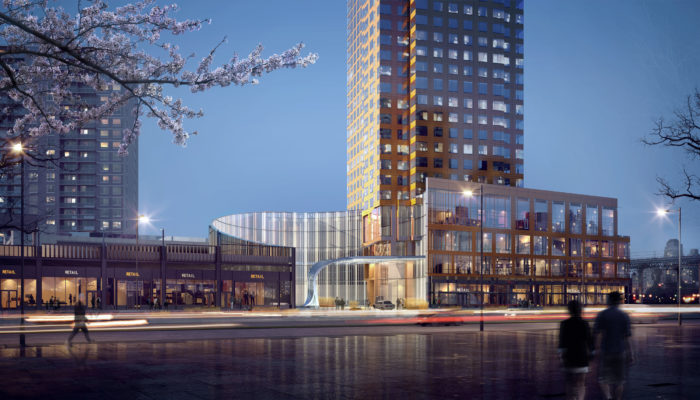
The Neptune/Sixth development will comprise two buildings, including one with 575 apartments (Rendering via S9 Architecture)
The area is known for its Russian émigré population, as well as a large African-American community. What it is not known for is luxury apartments and cloud-scraping, glassy residential buildings, the kind that have transformed Downtown Brooklyn. Among other developments, three massive projects are in the works for Coney: 1709 Surf Ave., a three-block, mixed-use complex to contain 1,000 apartments, 150,000 sq. ft. of retail, and 80,000 sq. ft. of offices, expected to be completed by 2020; 3514 Surf Ave., or “Ocean Dreams,” by mogul developer John Catsimatidis, a two-tower, 22-story, 425-unit undertaking with 20,685 sq. ft. of commercial space, expected to open by next summer; and Neptune/Sixth, a two-building development with one nearly complete seven-story, 161,000-sq.-ft. commercial structure at 626 Sheepshead Bay Rd. and a 70,000-sq.-ft. retail center with 575 apartments coming to 532 Neptune Ave.
In order to legally build a behemoth the size of Ocean Dreams, the developer had to acquire a rezoning and special permits via a Uniform Land Use Review (ULURP), which it received in 2011. This came on the heels of the Bloomberg Administration’s 2009 rezoning of Coney Island, which eased the way for hotel and residential development.
While the latter’s allowances have now been in place for close to a decade, it was not until more recently that major developers began to take advantage of them. The Great Recession and then Hurricane Sandy, which dealt a heavy blow and submerged swaths of the area, stymied developer momentum for several years.
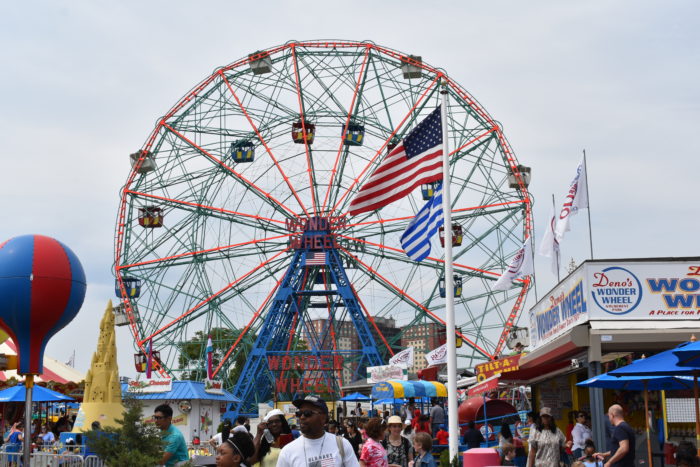
Deno’s Wonder Wheel, which has been turning at Coney Island for 98 years, is an official New York City landmark (Photo by Steve Koepp)
In large part, the current wave of development is what was intended in the 2009 plan: a jump start for an economically disadvantaged neighborhood. “There was a period of time when there was no private investment at all in Coney Island,” says Michael Sorrel, the owner of one of the boardwalk’s oldest businesses, Ruby’s Bar & Grill. “Over the last decade, you’ve seen a lot of investment in the community,” he told The Bridge. “Certainly the more people living in the neighborhood, the more likely they are to spend money in the neighborhood.”
While Sorrel said he “really can’t see [the development] being a bad thing” and sees the construction as necessary economic stimulus, he did bemoan its impact on Coney’s character. “For me, one of the charms of Coney Island is its edge,” he said, “and the fact that all this gentrification is going on and these new buildings are going up,Coney Island has kind of lost its edge.”
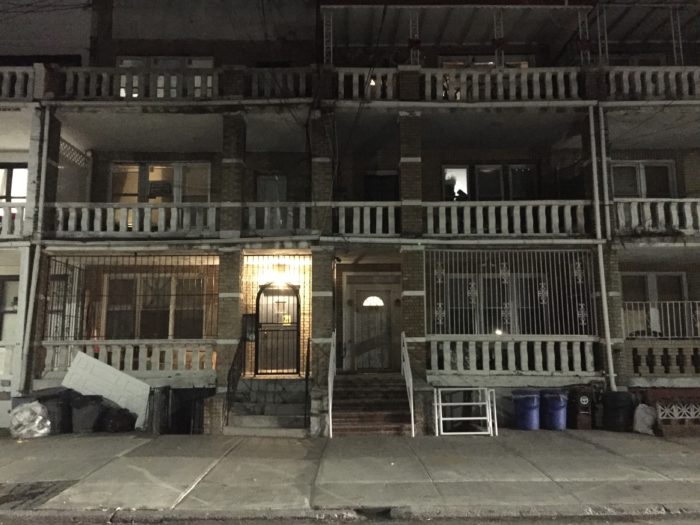
Row housing at night in Coney Island. Many houses were severely damaged by flooding during Hurricane Sandy (Photo by Tyler Woods)
“There’s a great disconnect here,” Council Member Mark Treyger, who represents Coney Island among other districts, said in an interview regarding the onslaught of high-end housing being created in the area. “There’s no supreme demand for luxury rentals or luxury condos.” Coney has many needs and problems, he said: a shortage of retail stores and transit choices, as well as being at the “epicenter of where you need to be evacuated from in a coastal storm.” But much of the development going on provides little relief for those issues.
“Ocean Dreams has no affordable housing, which to me is outrageous,” he said. This is in sharp contrast to Surf Vets Place, at 2006 Surf Ave. The first phase of the development, nine stories with 135 units, will contain 82 units for homeless veterans. Treyger lauds the veterans’ housing, while critiquing other new buildings as unaffordable to most of his constituents.
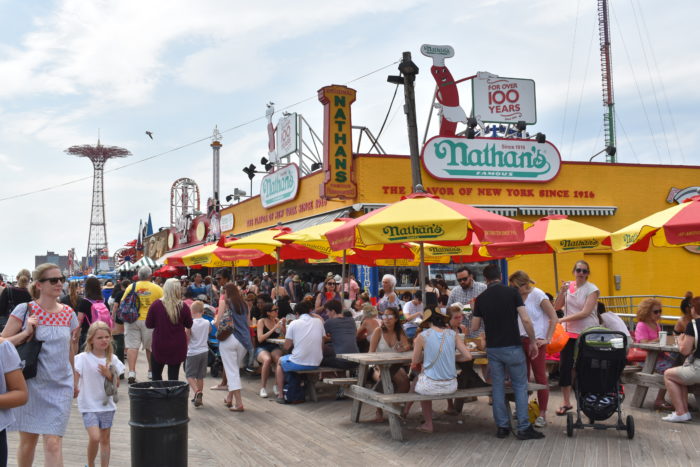
The boardwalk draws a diverse mix of New Yorkers on a summer afternoon, including fans of a famous frankfurter (Photo by Steve Koepp)
While Catsimatidis is planning a streetcar-like “Coney Island Trolley” from the Stillwell Avenue subway station to Ocean Dreams, on the whole there are no plans in place to update public transit despite the looming surge in population. “The train service is by Stillwell, where no one lives,” Treyger said. City officials and developers, he believes, are “just looking to add density without vision or discussion of transportation of people,” and failing to attempt or create “an overarching vision for a region that’s isolated.”
Civic leaders have proposed options. “We’ve been advocating F express service to be restored,” said Alexandra Silversmith, the executive director of the Alliance for Coney Island. “That service ended 30 years ago and the MTA was supposed to restore it, and they did not.” Coney Island was also bypassed in the initial rollout of the NYC Ferry. “I don’t think [the ferry] would be the silver bullet, unfortunately, but it would help,” Silversmith said.
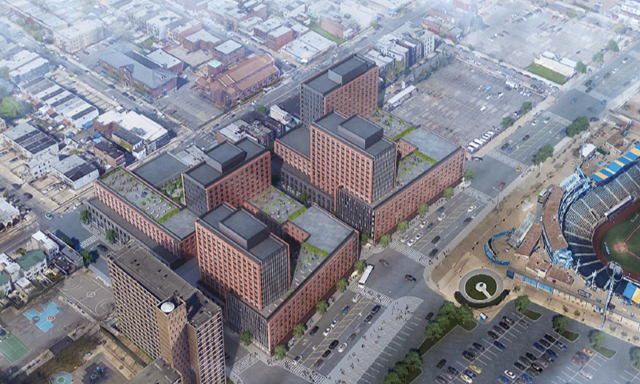
The sprawling development at 1709 Surf Ave. is expected to comprise 1,000 apartments (Rendering via the Prusik Group)
As Silversmith sees it, Coney Island needs more full-time residents to be a truly functional, year-round neighborhood, while today it remains something of a summer destination. “The revitalization is happening, it’s coming to fruition,” she said. That so much construction and change is happening at once, in part because of pent-up demand in the aftermath of Hurricane Sandy, has discombobulated the neighborhood to some extent. “There’s a lot of anxiety and tension,” Treyger said of the combined revitalization and construction efforts. “Everything has a cumulative effect when all the construction happens at once.”
Coney Island residents tend to have strongly mixed feelings about it all. On the one hand, they have to put up with disruptions–parking, traffic, noise–to produce luxury developments that aren’t intended for most of them. On the other hand, many at community-board meetings have expressed a sentiment not often heard in the more high-income Brooklyn neighborhoods undergoing such change: a sense of gratefulness that the area was having a comeback, that private developers were expressing interest in this slice of the borough, even if that brings fancier neighbors and higher rents.
There is, too, a sense of resignation less familiar in parts of Kings County more populated by newcomers who haven’t spent decades watching their hometown evolve. “Everything changes,” Sorrel told me on the phone, the familiar clatter of silverware audible in the background at the 84-year-old Ruby’s. “That’s the reality.”
And what of Coney’s celebrated weirdness? “You can still get a corn dog and a plate of fried clams. The Cyclone still gives people whiplash and the Wonder Wheel turns eternally on its sea-foam green spokes,” acknowledges Moss in his recent book. But he wonders what remains to surprise us. “What will shake us from our everyday lives, shocking and thrilling us with the unusual, the ambiguous, the fleshy, the loose? In a city so tightly curated and constrained, we are daily deprived of wonders hardly imagined.”
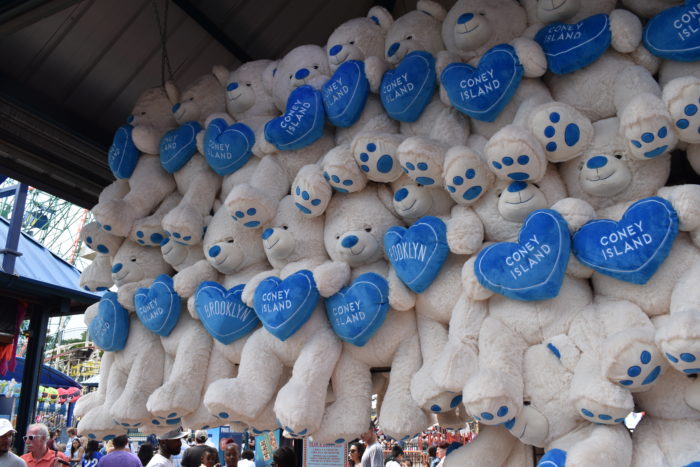
Coney Island’s midway attractions still offer games of skill–and plush rewards (Photo by Steve Koepp)